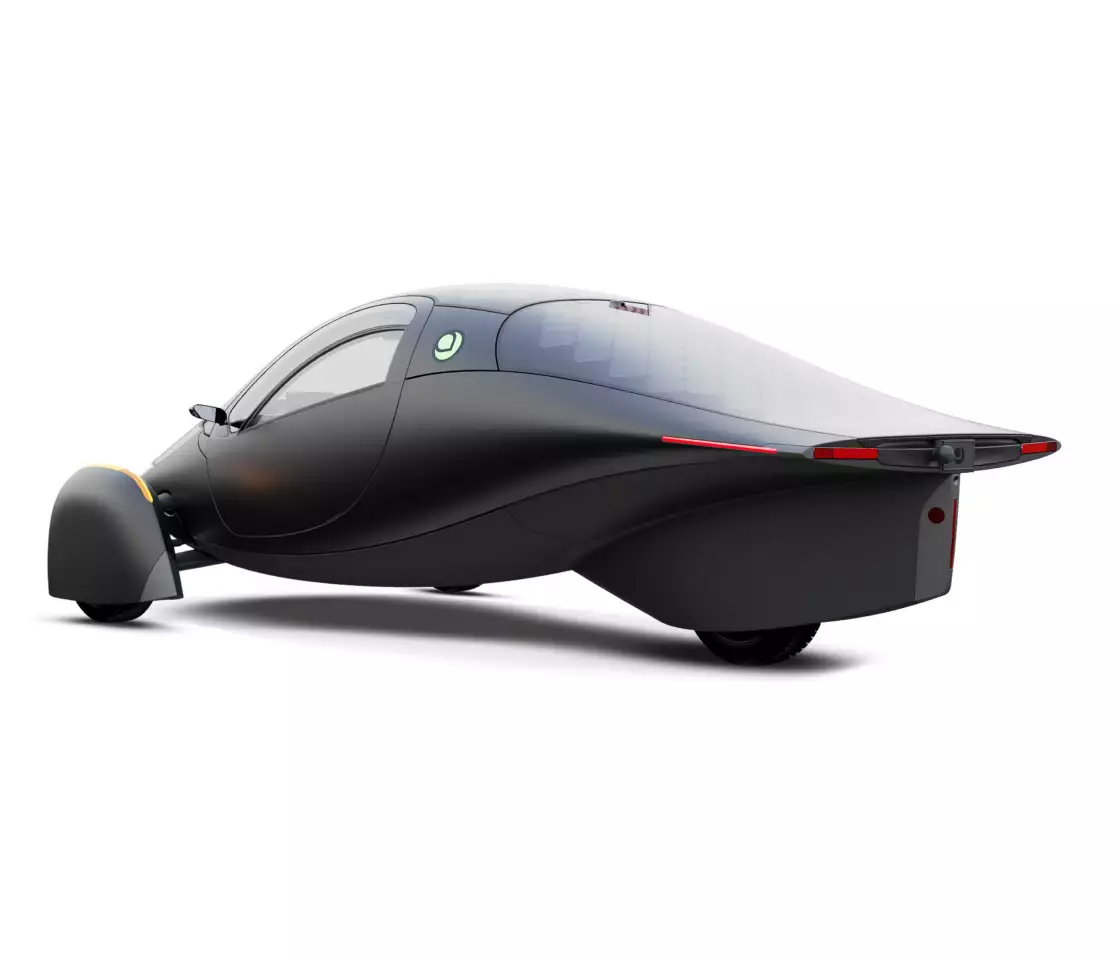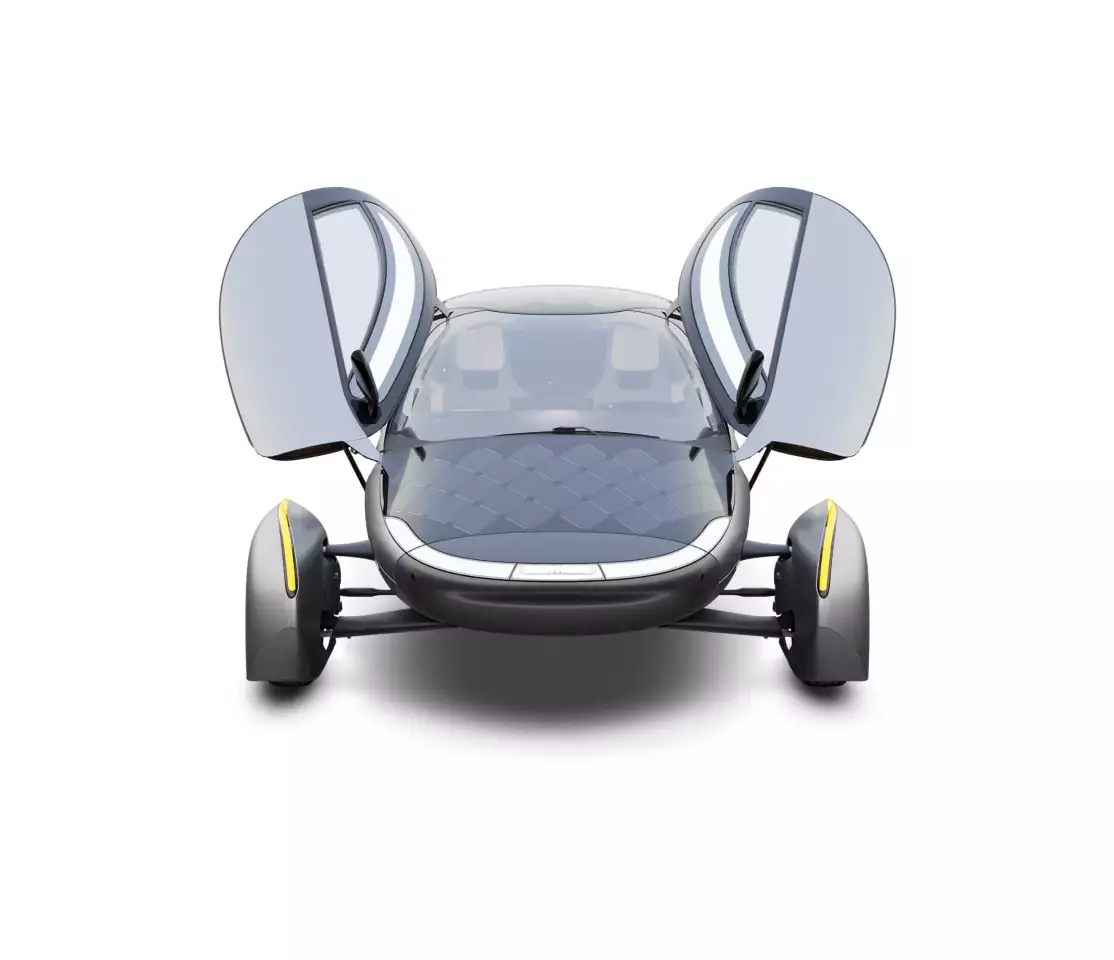Aptera Motors, based in San Diego, CA, has just successfully completed its first low-speed function test of its fully solar-powered electric vehicle (sEV). The PI2 doesn't need to be plugged in to recharge and instead gets its daily power directly from the sun.
The PI2 – Aptera's "Production Intent" vehicle – was stripped down in the parking lot test, devoid of any components that aren't required for driving the vehicle at low speed. This included the removal of the body panels, door panels, windows, solar panels, and the high-voltage system.
The Aptera is designed to be a fully solar-powered electric vehicle (sEV). Aptera claims it will have an additional 40 miles of range per day while not needing to be plugged in to recharge as it draws energy into its internal batteries from the sun. There are options for various battery pack sizes. One of which will offer up to 1,000 miles (1,600 km) of range when fully charged. Should you need to drive more than 40 miles a day or weather isn't allowing your Aptera its daily dose of sunlight, it can be plugged in to charge its battery pack.

In January of last year, Aptera announced the Launch Edition which featured roughly 700 watts of solar cells on the composite body and boasted a 400-mile range from a single charge to its 42 kWh lithium-ion battery pack. The integrated solar panels, of course, would continue to charge the batteries continuously as long as it's in the sun.
To put that in perspective, the Tesla Model S Long Range, equipped with a 100 kWh battery pack, has an estimated range of 405 miles.
Toyota's Prius offered solar panels on its vehicles in the past. Earlier models had around 180 watts of solar charging to the car's 12-volt system for running accessories in the vehicle – primarily to assist with the car's cabin fans to keep the interior cool. A later version of the Prius would also feed a small amount of power to the drive batteries, giving the car about an extra mile of range per day.

The 2020 Hyundai Sonata Hybrid also offered a solar roof option with about 200 watts of power, adding roughly 2 miles of range per day. Again, its primary purpose was to keep the 12-volt system charged, and not focused on the 270-volt system the electric drive motors use.
"Green" doesn't necessarily mean slow
With a claimed 0-60 mph (96 km/h) time of four seconds and a top speed of 101 mph (162 km/h), it's no slouch. While it's not exactly a rocketship, that kind of acceleration rivals that of a Chevy Corvette C6 or an Audi RS3. Its speed and efficiency can be lent to its 201 peak hp (150 kW) EMR3 drive unit. The electric drive train is capable of 228 lb-ft torque (310 Nm). When not mashing the go-fast pedal, the motor has a continuous power rating of about 67 hp (50 kW).
So, how does the Aptera add an extra forty miles of range from only 700 watts of solar? Its lightweight design and ultra-efficient drag coefficient. The 25 kW version is a mere 1,800 lb (816 kg), putting it in the same weight class as the tiny Smart car. Even the big 100 kW battery option with 1,000 miles (1,600 km) of range weighs only 2,200 lb (998 kw), putting it right around a Gen 1 Mazda Miata's heft.

The Aptera has a six-piece carbon fiber composite body made in Modena, Italy – birthplace to Enzo Ferrari, and which the 360 Modena took its name from. The Aptera's unique, three-wheeled design makes it as aerodynamic as possible to use as little energy as possible while driving.
The Aptera has a drag coefficient of 0.13. I'll just write that one more time for dramatic effect: The Aptera has a drag coefficient of zero point one three.
Drag coefficients measure how much resistance an object has against the flow of air or fluid while moving.
For those who aren't aerodynamicists, a parachute for jumping out of planes has a drag coefficient of about 1.4 to prevent you from falling to your death. A semi-truck/big rig for transporting goods across the country has about a 0.6 drag coefficient; you certainly feel it every time you try to pass one on the freeway and it blows you to the side as it's pushing so much air.
A protoype called the EXE181 – built to be the most slippery car the world has ever seen – claims a drag coefficient of 0.181.
ThrustSSC, the British jet car that has held the current world land-speed record since 1997 of 763 miles per hour (1,228 km/h) across a 13-mile long track in the Black Rock Desert of Nevada (hello, Burning Man) – the first and ONLY vehicle to break the sound barrier on land – has a drag coefficient of 0.16.
"Aptera’s undercarriage swoops like a dolphin’s belly. This reduces drag."

It sure does. That message is stated in bold letters on Aptera's website. And in case you're wondering, a dolphin's drag coefficient is right around 0.004.
To further reduce vehicle weight, Aptera has collocated most control boards to reduce wiring harness weight and reduced wire connector sizes. The car company has gone so far as to eliminate most controller board covers for weight reduction allowing the Aptera to get the most efficiency out of the sun's energy. Instead, the control boards are covered with a dust and water-proof coating.
At the time of writing, if you click "reserve" on Aptera's website, the Launch Edition price is listed at US$30,700 with a note "price subject to change." When fully spec'd out with all the bells and whistles, the Launch Edition tops out at $51,500.

A brief history
Going back to 2008, Aptera produced the world's first 300 MPG electric-hybrid prototype called the Typ-1h. Aptera also produced an all-electric version with a 120-mile range called the Typ-1e. The Typ-1 successor, the 2e prototype (electric only) was released a year later, switching from rear wheel drive to front wheel drive and adding a few other creature comforts as well as safety features.
The design was so futuristic that it appeared in the 2009 reboot of Star Trek, seen driving by in front of Starfleet Academy right before Kirk takes the Kobayashi Maru simulation for the third time.
The world wasn't ready for the Typ-1 or 2e and Aptera Motors ceased operations in 2011 when it ran out of money. Full stop. No vehicles were delivered, though $500 reservations were taken.
In 2019, original founders Steve Fambro and Chris Anthony hadn't given up on the dream and picked up the reigns once again and began development of the Launch Edition – the now-to-be solar-powered three-wheeled car that's classified as a motorcycle.
Why PI2? Because PI1 was essentially just a shell of a car used for fitment tests of Aptera's wiring harness and cable measurements.
Once all testing has been completed, Aptera's goal for full-scale production will be 40 vehicles per day from its final assembly plant in Carlsbad, California.
In the low speed test video below, Steve Fambro, CEO of Aptera goes on to say, "The team has taken it back. They're adding some retrofit items into the high voltage system that we want to for high-speed driving." High-speed validation tests come next. We can't wait.
Source: Aptera











